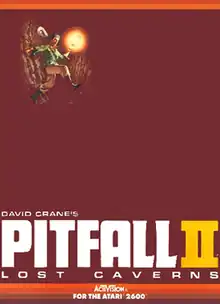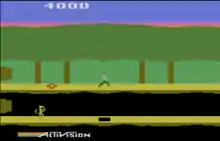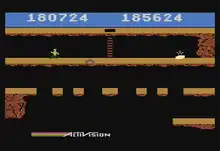Pitfall II: Lost Caverns
Pitfall II: Lost Caverns is a platform game originally released for the Atari 2600 by Activision in 1984.[1] It is the sequel to Pitfall! (1982). Both games were designed and programmed by David Crane and star jungle explorer Pitfall Harry. Pitfall II adds a much larger world with vertical scrolling, swimmable rivers with deadly eels, music, and balloons for floating between locations.
| Pitfall II: Lost Caverns | |
|---|---|
 Atari 2600 cover art | |
| Developer(s) | Activision |
| Publisher(s) | Activision |
| Designer(s) | David Crane[1] |
| Programmer(s) | Atari 2600 David Crane Atari 8-bit Mike Lorenzen[1] TRS-80 CoCo Steve Bjork[2] |
| Platform(s) | Atari 2600, Apple II, Atari 5200, Atari 8-bit, ColecoVision, Commodore 64, MSX, IBM PCjr, SG-1000, TRS-80 Color Computer, ZX Spectrum |
| Release | Atari 2600 |
| Genre(s) | Platform |
| Mode(s) | Single-player |
Published after the video game crash of 1983 when interest in the 2600 was waning, Pitfall II was one of the last major releases for the console and one of the most technically impressive. The cartridge contains a custom "Display Processor Chip" designed by Crane, for improved visuals and four-channel music instead of the two the system is normally capable of.[4]
Pitfall II was ported to the Atari 5200, ColecoVision, TRS-80 Color Computer, Apple II, Atari 8-bit family, MSX, Commodore 64, and the IBM PCjr (as a cartridge). In 1985, Sega released an arcade game titled Pitfall II - The Lost Caverns with a new visual style and gameplay elements from both the Atari 2600 Pitfall! games. It was ported to the SG-1000 console in Japan. The game's plot was loosely remade into Super Pitfall for the Famicom/NES.
Gameplay
In Pitfall!, Pitfall Harry avoids crocodiles, scorpions, cobras, bats and quicksand across a series of horizontal screens. Lost Caverns dramatically expands the scope of the environment, as Harry descends into a deep, vertically scrolling underground. Unlike the first game, Harry has unlimited time and lives, making it impossible to die or lose. When Harry touches a dangerous creature, he loses points as he moves back to the last continue point (marked with a red cross) he touched along his journey.[5]

Pitfall II has 27 horizontal levels. These levels span eight screens in width but are not openly accessible all the way across; some portions are blocked by cave walls that force Harry to travel through other areas in order to progress. Quicksand and tar pits are replaced by rivers and chasms. Balloons let Harry ascend to new areas.[5]
Two characters debut in Lost Caverns: Quickclaw, Harry's cowardly pet mountain lion, and Rhonda, his adventure-seeking niece. Both characters were created for the Saturday Supercade cartoon based on Pitfall! a year before this game was released. Upon collecting Rhonda, Quickclaw, and a diamond ring, the game ends.[5] Optional items can be collected for points. The maximum possible score is 199,000.[6]
Musical cues act as subtle rewards and punishments for performance. The main theme plays for a short while before reaching a loop of acoustic music. When Harry collects a treasure, the main theme begins again. When Harry returns to a continue point, a slower, minor key version of the theme plays. If Harry ascends using the balloon, Sobre las Olas ("Over the Waves") is played.
Ports

The Atari 5200 and Atari 8-bit computer versions, called the Adventurer's Edition on their title screens, contain additional content. Programmer Mike Lorenzen reused David Crane's code from the 2600 version and added an entirely new level to the game, which was playable after the initial game was finished.[7] Marketing would not allow the two versions to be different so the new level was relegated to an Easter egg.[8]
Reception
Computer and Video Games magazine rated the ColecoVision version 81% in 1989.[9] In their list of the top 25 Atari 2600 games, Stuart Hunt and Darran Jones listed Pitfall II: Lost Caverns in the number one spot.[10] The two writers found the game far more ambitious than the original and that the game was "as playable today s it ever was."[10]
Gamasutra included it as an open world game in their Game Design Essentials series.[11]
References
- Hague, James. "The Giant List of Classic Game Programmers".
- Boyle, L. Curtis. "Pitfall II". Tandy Color Computer Games.
- "Pitfall II (Registration Number PA0000276113)". United States Copyright Office. Retrieved 6 June 2021.
- "Description of the Pitfall II cartridge". Biglist.com. Retrieved 2013-02-11.
- Pitfall II: Lost Caverns Atari 2600 manual. Activision. 1984.
- "AtariAge - Atari 2600 Manuals - Pitfall II: Lost Caverns (Activision)".
- "Reminiscing with David Crane". Archived from the original on 2007-12-24. Retrieved 2007-11-07.
- Brad Fregger (2020-10-24). The world's greatest videogame easter egg DOESN'T EXIST (*for legal reasons) Pitfall 2 Atari 800!. Event occurs at 6:56. Retrieved 2020-10-24.
- "Complete Games Guide" (PDF). Computer and Video Games (Complete Guide to Consoles): 46–77. 16 October 1989.
- Jones & Hunt.
- "Gamasutra - Game Design Essentials: 20 Open World Games".
Sources
- Jones, Darran; Hunt, Stuart. "Top 25 Atari 2600 Games". Retro Gamer. No. 46. p. 33.
External links
- Pitfall II: Lost Caverns for the Atari 2600 at Atari Mania
- Pitfall II: Lost Caverns at Lemon 64
- Pitfall II: Lost Caverns at SpectrumComputing.co.uk
- The Atari 2600 version of Pitfall II: Lost Caverns can be played for free in the browser at the Internet Archive
- David Crane explains how the DPC sound chip works